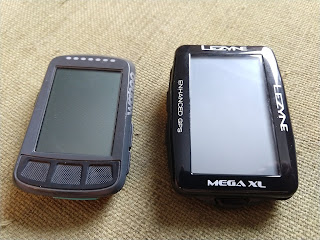Ibis Ripmo Price Differences
The Ripmo Deore build costs $5299, while the XT build is $6899 - that's a difference of $1,600. That's a lot of money - where is it all going? For the most part, the components are all the same. Let's look at the differences:
- Every Deore item is XT
- Brakes - $425
- Rotors - $58
- Cranks - $160
- Bottom Bracket - $33
- Rear Derailleur - $120
- Shifter - $63
- Cassette - $165
- Chain - $46
- Handlebars are the Ibis 800mm HiFi (which is made of carbon fiber). $169.
- Seatpost is a Bike Yoke Revive instead of the KS Rage-i dropper. Posts are slightly larger on the BIke Yoke. This is a $400 dropper.
- Stem is an Industry Nine A318 instead of Ibis. $155 stem.
All told, that adds up to $1,852 of components. So if you bought a Deore Ripmo and upgraded the entire thing to this kit, you'd have spent $253 more than just buying XT to begin with - but you'd have a bunch of Deore stuff, too, which you could probably resell for more than the difference. This assumes that you're not paying for labor.
However, some of these are a higher value than others.
The Deore 6120 brakes weigh ~312g for a lever and caliper. XT brakes are listed as a bit heavier because they include the caliper! Weird. Apparently the 8100 is ~564g for a pair, so that's ~282g each. So ~60g saved on brakes. The XT brakes give you a few nicer features and better machining, too.
The rotors are probably a bigger difference. The IceTech is a decent increase in performance, even if they weigh about the same.
Cranks are a good upgrade. The Deore cranks are quite heavy, but the difference between SLX and XT is pretty tiny - about 4-10g. SLX is a nearly 100g weight reduction, so that's worthwhile.
The bottom bracket with the higher level is probably more reliable. This is a wear item, so just get the nicer one when it is time.
The XT RD is 284g vs 320g. 36g isn't a huge upgrade, and there's little functionality increase.
The shifter is a nice difference - for only $63, you get two upshifts. The weight is the same, but performance is better, too.
The cassette is a wear item, but also a big weight upgrade. The Deore one weighs 596g, and XT is 475g. 121g is a decent bit of weight, especially since it is rotating on the wheel and unsprung weight.
The chain is also a wear item. You only save about 20g on this one, so may not be worthwhile to upgrade.
I'm not a fan of the KS dropper posts- I've had a ton of problems with them. The 150mm Rage-i weighs 570g. The 160mm Revive weighs about 535g. A PNW Components Loam dropper is about $200 and weighs 524g for 150mm travel (or 554g for 170mm of travel). Not a huge weight savings, but when the KS starts to die, that's what'll go on.
Carbon handlebars are nice, no denying it. The HiFi bars are adjustable in length and weigh 249g. The alloy bar weighs 263g. You also get vibration dampening and less temperature suck in the cold. I'd probably opt for lighter bars if I were going carbon - seems like ~180-200g is common. Saving 50-70g isn't nothing, especially high up on the bike and in a control point.
The I9 stem is Made In America, which is cool, but it's 'just' an alloy stem. If I'm paying a premium for my stem, I'd like to pick the color at least, or spring for carbon. The A35 50mm stem weighs 150g, while a Salsa Guide weighs 159g. Meanwhile, the ENVE M6 stem comes in at 96g, albeit for $280 instead of the $155 of the I9.
In summary, I'm super pleased with my Deore Ripmo. I've upgraded the cranks to SLX, saving ~100g in weight and getting the 165mm crank arms that I like best. Next upgrade is going to be a new wheelset with some faster engaging hubs, slightly narrower rims, and lighter weight, along with some smaller/lighter tires - the 2.5" Assegai front-and-rear are far more powerful than I need. A Dissector/DHF combo is looking likely.

Comments
Post a Comment